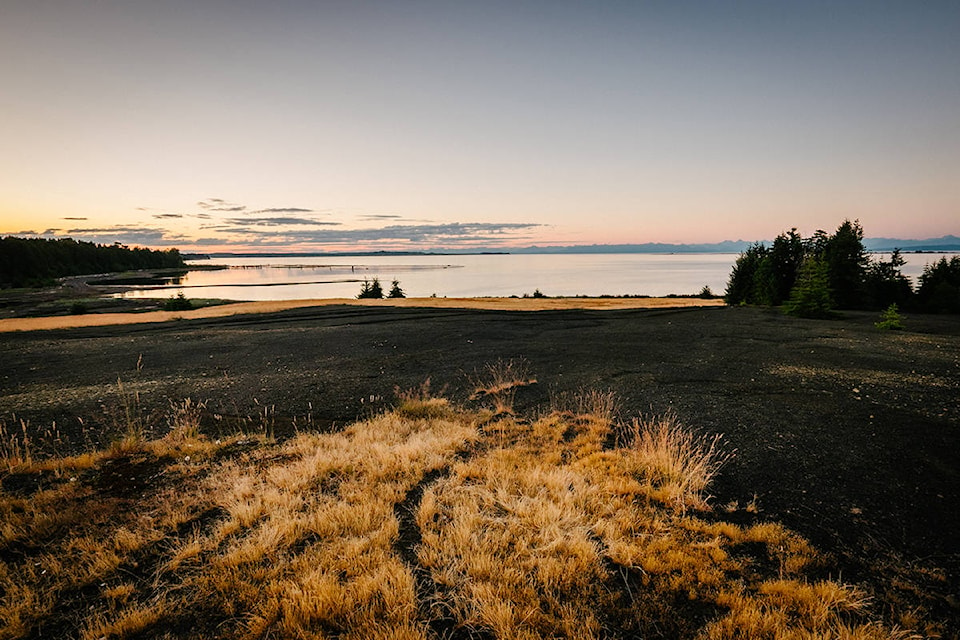A recent subdivision in Union Bay has some residents scratching their heads, after a property development company that owns 1,000 acres of land sold a portion of it to the provincial government for a dollar.
In April, Kensington Island Properties (KIP) sold 28.32 acres of contaminated land in Union Bay to the Ministry of Forests, Lands and Natural Resource Operations. The land was sold for one dollar and “other valuable consideration.” The Land Titles and Survey Authority in Victoria registered the transaction on April 20.
Even though the subdivision has been registered, some Union Bay residents (some of whom blog for the website allthingsunionbay.com) are questioning the process in which it was approved.
The land is located on a portion of Union Bay’s coal waste hills, an area the province has recognized since 2012 as a “priority contaminated site.” Now that it owns the land, the B.C. government is planning to create a green space there once the area is eventually remediated.
KIP bought more than 1,000 acres of land in Union Bay in the late 1990s, with the long-term goal of building a golf course, a marina walkway, a water filtration system and housing developments for the small seaside community.
Due to several political and regulatory hurdles over the years — as well as a few legal battles — none of the projects have been realized.
While it was registered under section 99 of the B.C. Land Title Act, some residents are upset with how the subdivision was ultimately approved by the Land Titles and Survey Authority office (LTSA).
In order to subdivide land within unincorporated communities, an application should first go through the Ministry of Transportation and Infrastructure (MoTI) for preliminary approval. Depending on the subdivision, MoTI then forwards applications to the regional district or other bodies as referral agencies. Every subdivision requires an “approving officer,” which in rural areas will be either MoTI or the regional district.
Documents show the Comox Valley Regional District did not know about the transaction between KIP and the province until early May, a few weeks after the subdivision had already been registered. This occurred even though the CVRD has a section 219 covenant with KIP that prohibits subdivisions until certain terms of a Master Development Agreement (MDA) signed in 2010 are met.
A June 19 email to the LTSA from CVRD chief administrative officer Russel Dyson suggests that the subdivision was approved behind the regional district’s back.
“I would appreciate an explanation as to why the creation of this new lot was approved without referral and approval by the CVRD,” reads a portion of Dyson’s email, obtained by the Record.
The LTSA responded to Dyson on Sept. 25, confirming that the land transfer had not received the regional district’s consent.
The letter, also obtained by the Record, admits that the subdivision plan was “registered in error” and that the examiner of the plan had missed the provisions of the covenant.
“It is our practice to review all registered covenants and other encumbrances to confirm there are no barriers to registering a plan submitted under section 99(1)(h),” reads a portion of the letter, written by the registrar of land titles, Carlos MacDonald.
“The plan should not have been registered without the CVRD’s consent. I’m sorry this happened under my watch.”
In an interview, MacDonald confirmed that human error led to the office missing the covenant in its review process.
“This is one where the CVRD needed to consent because of that section 219 covenant that restricted subdivision. Our examination staff that reviewed the plan missed the covenant,” he said.
MacDonald said the LTSA processes upwards of four million transactions per year, with an error rate of between 0.1 and 0.4 per cent.
“And that’s for all errors, including typos,” he said. “This one as far as mistakes go is more serious, as it has affected another party’s interest. Our error rate is incredibly low, but we still have humans reviewing stuff, and with that comes the potential for human error.”
Due to the Torrens land title system used by the LTSA, MacDonald wrote that the land transfer is non-reversible.
“Unfortunately with the error we made, we’re stuck with it,” he said. “From the Land Title perspective, there may not be a remedy for [the CVRD] in our system, but I would imagine — but this is not my purview — they likely could have a claim against the developer for breach of contract.”
KIP vice-president Brian McMahon said the fact the CVRD did not know about the transaction until after it occurred was an oversight and not done intentionally.
“It was something that when the province said ‘now,’ we had to move now,” he told the Record. “There was no intent to deceive anybody or go against the regional district. It was the province that said, ‘it has to happen now.’ It was a section 99 transfer.”
The 28 acres that KIP sold to the province was previously slated to house some of the developer’s proposed golf course. McMahon said the golf course project is still a go, as well as the company’s other development plans in Union Bay.
(Photo of coal hills courtesy Dave Ingram, http://DaveIngram.ca)
